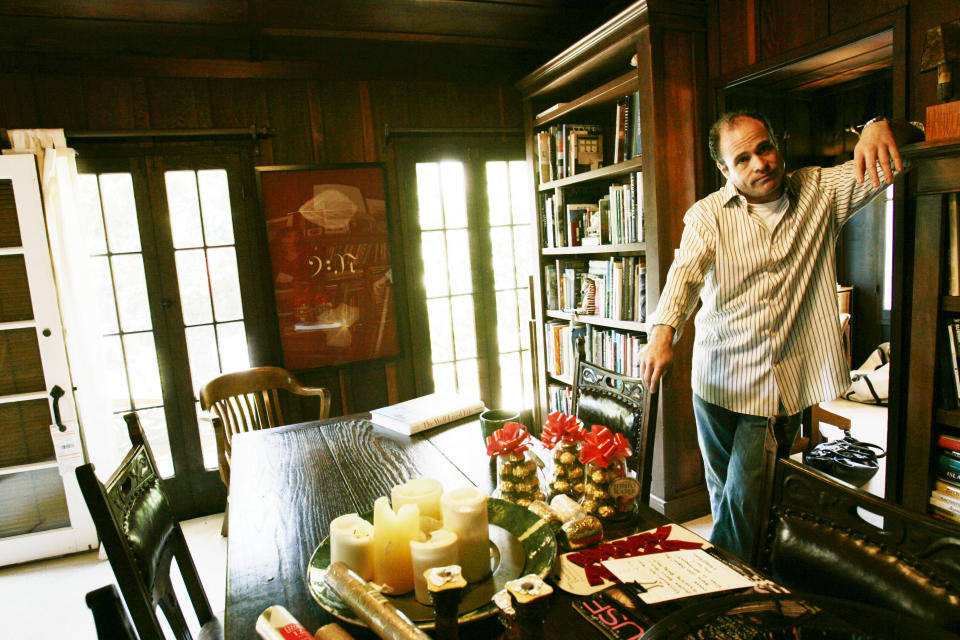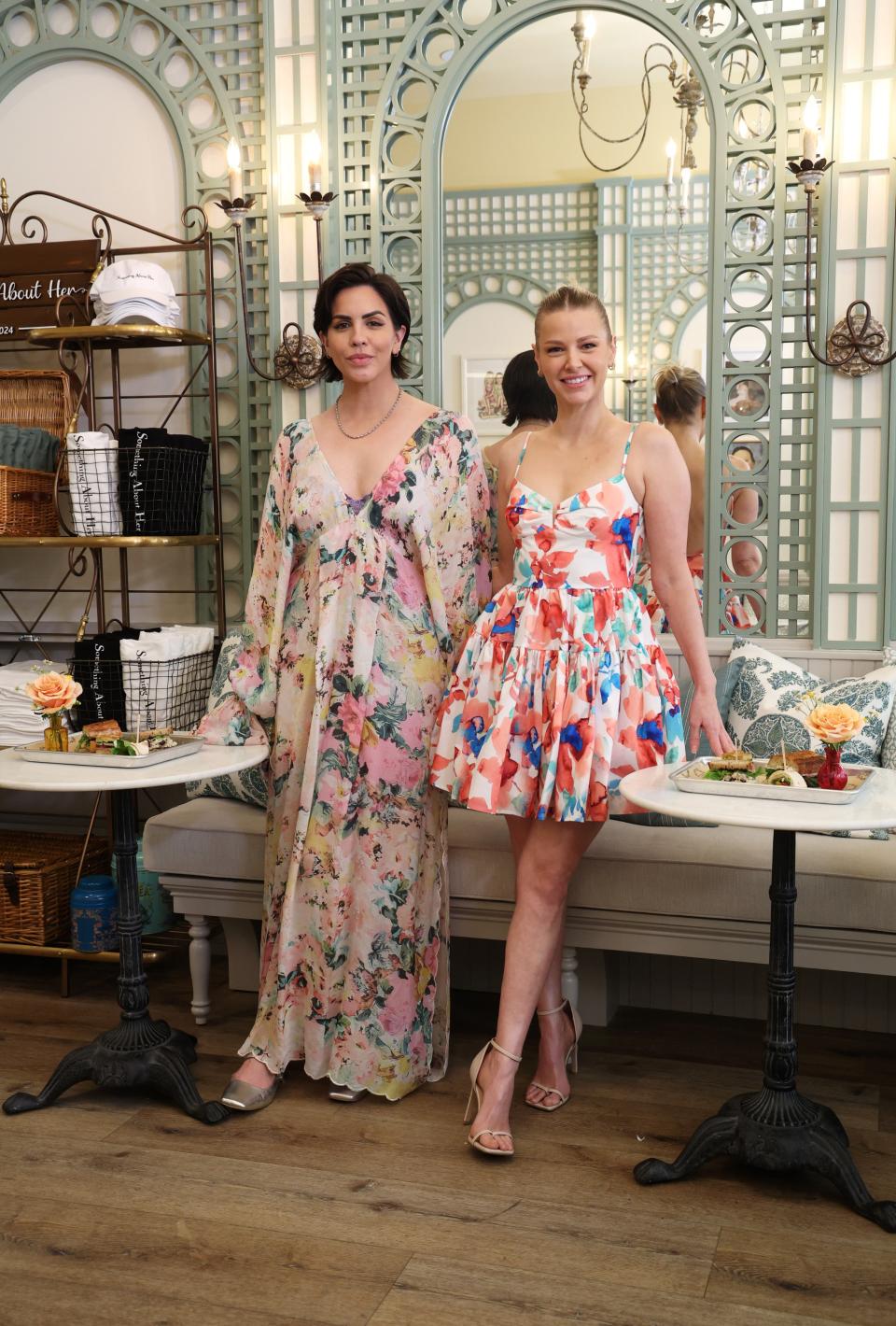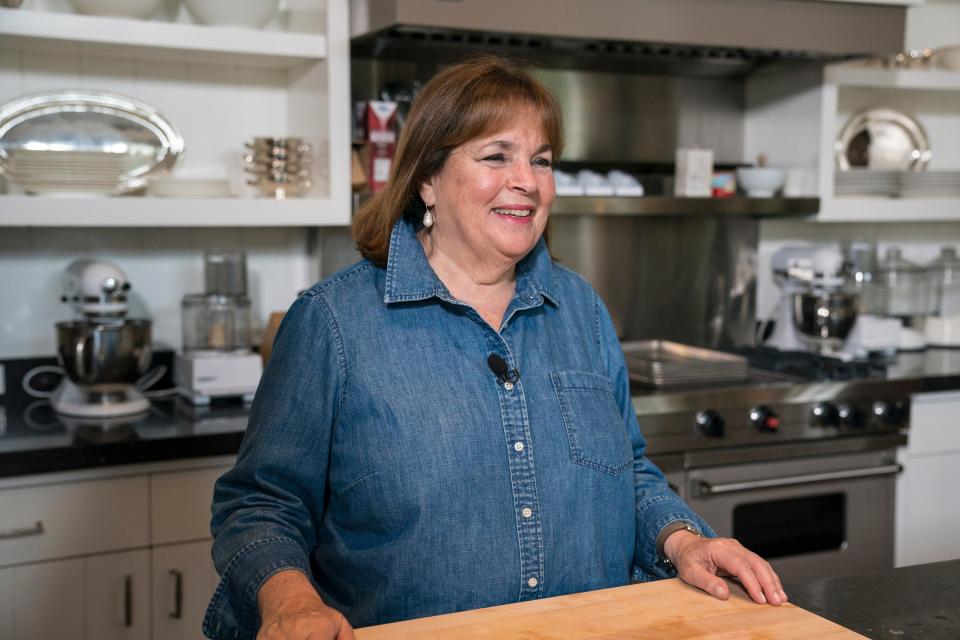45 Minutes With Jon Hutman, the Designer Behind Something About Her and Nancy Meyers’s Movies

Jon Hutman isn't sure how to define Nancy Meyers–core. Ironic, given that he all but invented it. As the production designer for all of Meyers’s films since What Women Want, Hutman has been a crucial influence in creating the warm, tastefully lived-in interiors that have defined the visual language of movies like It’s Complicated, The Holiday, and Something’s Gotta Give.
But when pressed, Hutman describes the Nancy Meyers “angle” as classic, timeless, and comfortable. A “casual elegance,” if you will.

Jon Hutman at his home Santa Monica an Uplighter cabin that dates back to the 1920's, is the set des
Those are also words that could be used to describe the interiors of Something About Her, the new sandwich shop from Vanderpump Rules stars Katie Maloney and Ariana Madix that he also designed. Inside the LA café you’ll find a room well-lit by chandeliers and wall sconces, with cozy pillows in soft blues and whites set against a wall of curated portraits of women. If you think that sounds like the set of a Nancy Meyers movie…well, yeah, that’s the whole point.
“Nancy Meyers’s sets are always so timeless and cozy, and we just want to live inside them,” Maloney tells Glamour. “That’s what we wanted to bring to this space. We didn’t want it to feel like a trendy LA café. We wanted it to feel like you were a main character in a rom-com.”
So they went straight to the source and asked Hutman to design the space. In a moment of kismet, the Meyers movie he was working on had recently been shut down and he found himself available and looking for his next project.
“Our original vision for this space was very much ‘European café meets Nancy Meyers,’” Maloney says. “He really turned it out amazingly.”
Adds Madix, “A lot of it is classic, cozy, timeless, but also somewhat expected. Like I’ve seen elements of these things in other places, but I’ve never seen all of them together.”

Katie Maloney And Ariana Madix Celebrate The Opening Of Their New Sandwich Shop "Something About Her"
Ever the savvy businesswomen, Madix and Maloney seem to have have yet again hit the zeitgeist at the right moment in time. The quirky maximalism decor trends of the recent past have given way to more cozy comforts, making searches related to “Nancy Meyers homes” soar on Pinterest. On TikTok, over 9.5 million posts have been dedicated to achieving the Meyers aesthetic, while niche trends seemingly inspired by the director, like coastal grandmother, have become household names. (Just don’t mention that to Hutman. “I really hate this coastal-grandma thing,” he says. “That wasn’t the idea.”)
So, just like Madix and Maloney, I wanted to go straight to the source: Hutman. We spent 45 minutes talking about everything from Nancy Meyers–core to his design process and the inspiration for Something About Her.
Glamour: Let’s start with Something About Her, which was inspired by Nancy Meyers movies. What was your design inspiration for it? What were you looking for?
Jon Hutman: So, a little over a year ago, I was working on another Nancy Meyers movie that ended up not happening. We got shut down by the studio on a Friday. And that Sunday I get this email on my website from a very nice woman saying, “My friend and I are opening a sandwich shop in West Hollywood. We love Nancy Meyers movies. Is there any way you could help us with this place?” I had just become unemployed, and I was like, “Sure.” So I met these women. I had no idea who they were. I did not watch reality TV. And they could not have been nicer. We walked into this little empty shop on Robertson Boulevard that was literally four blank white walls. They had a Pinterest page and some pictures. And I came back to them and said, “If you like this, how about this?” It took off from there. They wanted to serve sandwiches, tea, and wine. There’s no coffee. The idea was to find something that was romantic, inviting, and feminine but also fresh.
How would you define Nancy Meyers–core? When you hear that term, what does that mean to you?
Well, I don’t know what core means.
It means aesthetic, in this context.
I think the look that people associate most strongly with Nancy comes from Something’s Gotta Give, number one, and It’s Complicated, number two. Those films are both…when I say autobiographical, it’s not that it is her, but her soul is in those movies, and everybody knows that Nancy loves design. What I’m always quick to say is this: People remember those movies and those houses because of the story that happens there.
As the interest in the sets and the houses has endured, I think it’s really important to remind people that when we were doing Something’s Gotta Give, I visited all these houses in the Hamptons and looked at all these books, and we did our best to synthesize the best elements of this and that, but it’s very personal.
Celebrity Homes
This was Garten’s first kitchen renovation in 25 years.
There is an aesthetic, which—look, I really hate this coastal-grandma thing. That wasn’t the idea. The idea was, Where does an educated, sophisticated, successful woman live? When somebody buys a house in the Hamptons, it’s their second house. It’s like, where do I go to breathe? Where do I go to relax, and what does that look and feel like? Before we went to the Hamptons, Ina Garten was doing it at the Barefoot Contessa. Meryl Streep’s world in It’s Complicated is in Santa Barbara, and it’s the West Coast equivalent of that.
What I think both of those movies capture—again, in the spirit of the script and the story and the characters—is this kind of casual elegance. It is aspirational, but it’s comfortable. Elegant has always been a little stiff and uptight.
So if someone wanted to replicate or honor that feeling in their own home, what kind of pieces should they be looking for? Any tips on how to get that vibe?
When I design a set, it always starts with the container of space. So rather than getting a few little objects and knickknacks, you start with the space. You build it out with some kind of architectural detail, which can be clean and modern. It can be a little bit beachy; it can be classic colonial Georgian. It can be whatever your vibe is. For me, places turn out better when you embrace the architecture that’s there. So if you really want to get granular with it, what’s the difference between the Hamptons and Santa Barbara? It’s subtle, but they’re different.
What are the differences?
What’s the difference between Meryl’s house in It’s Complicated, which is a one-story Spanish-style ranch house in Santa Barbara, and Cameron Diaz’s house in The Holiday, which is a two-story Spanish revival in Pasadena designed by Wallace Neff, who’s a famous architect? It was his own house. We built the interior on stage and brought in this contemporary Belgian aesthetic, which at the time was before Restoration Hardware and everybody else did that. But each of those places embraces the place, the architecture, and the aesthetic of the person who lives there.
Anybody can find a tchotchke. The challenge is to not overclutter it up and to find the essential elements which live in the space. If you want to get into the sidebar of my pet peeve with modern design…back in the day, the first interior decorating show that I remember was called Trading Spaces. It was really fun. The next-door neighbors did each other’s houses, and it was cheap, accessible makeovers. But what has happened over time between Joanna Gaines and the Property Brothers is everybody…the idea is to go into a house, rip out all the walls, and build the kitchen into the living room. At a certain point it’s like, “Fine, as long as you don’t cook.” But I don’t want pot roast in my bedroom. You know what I mean? That’s my new reality show: putting the walls back in.
We need defined spaces. I totally agree.
Whether you get inspired by one of Nancy’s movies or by Something About Her or a Pinterest board or whatever, my number one advice to people is: Don’t put everything in. So the idea of, “Oh, I want this chair, and this table, and this lamp, and this little thing, and this pillow, and this thing….” It will be a mess. Be simple and limit the number of aesthetic choices, whether it’s the furniture or the fabrics. Keep it clean and simple, and make it personal.
In the café, which is the current example, there was this general idea and inspiration, and then there’s a little bit of a Euro element. My favorite cafés that I pulled research from tend to be English and French because I think I’m fancy and whatever, but it also wants to be accessible. When it came to the art on the walls, I was going to do these large black-and-white photos from the South of France in the ’20s…and it felt a little dead. I thought, There needs to be color there, and they need to be images of women. You don’t need to know who they are, but no matter which one you look at, you need to be drawn to her. There’s something about her that draws you to her. That was some representation of Katie and Ariana and the spirit of the world they were creating. That made it personal.
Cover Story
Before *Vanderpump Rules*, before Scandoval, before the (almost) 2 million Instagram followers, she was a master of reinvention. The newest version of Ariana Madix? Stronger, freer, and—yes—richer.
It’s a small room, but there’s this antique brass baker’s rack because they wanted to have a place where they could put their merch. Because it’s all about merch. Sandwiches and merch. If you look at the light fixtures, like the sconces and the chandeliers, there’s a patina of history that feels like it’s not brand-new. People should always find something that represents themselves, as opposed to, “Oh, I want what Katie and Ariana have. I want what Nancy has.” People love the movies, the sets, and Nancy’s aesthetic because it’s her. It’s personal. That’s what people connect with. You know what I mean?
Yes. My grandmother had a very specific design style, which has trickled down to everyone in the family. I can’t describe it, but my home, my aunt’s home, my cousin’s home…we all have our own individual tastes, but they speak the same visual language. They’re in conversation with each other. Somebody could walk into each of our homes and know we’re related somehow.
I think that is 100% right. And by the way, you don’t just want to pull out every piece of furniture from your grandmother’s house and put it in your apartment because then it’s going to feel like an old lady’s house, right?
Nancy was really into this Belgian decorator, Axel Vervoordt, who’s very well-known. He takes ancient pieces but uses them in a modern way. Each piece becomes a piece of sculpture in a big, open, modern space. I did a movie called The Tourist in Venice, and Axel has an apartment in Venice, and we did this amazing apartment in an area called Giudecca that was very much inspired by him. A lot of it was inspired by him because his aesthetic lives and works really well in Europe in an ancient place that you strip down to modern, and then you put these carefully curated pieces inside of it. It’s this eclectic mix, but the design process is to find what inspires you. You don’t just copy it, right? How do you make it yours? That’s my thing.
So let’s say you're decorating a living room. You have four blank walls. Do you start with the rug, the couch? What’s the first thing?
Here is what I learned by doing interiors, which is my sideline business in between movies: You start with the art. If you look at the greatest spaces, it always starts with the art in terms of scale, in terms of focal point, and in terms of palette. Start with the things that are least flexible.
You can’t have the most important painting with the most important rug with the most important furniture. Do you see what I’m saying? There has to be a visual hierarchy. If everything is shouting at the same volume…it’s like in a symphony. Someone gets to play the melody, and someone is the supporting base, and someone comes in with a counterpoint, and that’s how you try to orchestrate a room. I need to start big to small, but I may find two chairs and go, “You know what? We have to build the room around these chairs.” There are no rules. I’m just describing for you in general how the process works for me.
So in a world of Amazon, Wayfair, and other quick-hit places, where do you recommend looking when someone is shopping for interiors? Where can you find things that are personal and not too low-quality?
Well, there are a couple of things. Obviously, you can go to Chairish or 1stDibs, or there’s a more European site called Pamono, which is actually owned by Chairish. And believe it or not, you heard it here: Etsy. You can find stuff on eBay, but the eBay search engine is really challenging, and the Etsy search engine is only slightly less challenging.
I will tell you, there are two rugs sitting on the chair by my front door, which I ordered in good faith, opened them up, and they looked nothing like I expected them to look. And I do this for a living. So one rule is if you’re going to order online, make sure that they pay for the return shipping. Don’t be afraid to order four things and return three of them. Rugs, especially. Rugs are really, really…
Oh God, the colors are always so different from what the pictures show.
I’m doing this little job for a friend of mine whose parents are moving into a home, and oh my God, you want to kill yourself. But that’s my job; it’s like a scavenger hunt to even find a physical fabric sample, and then you get it and you make sure that this one goes with that one.
Anyway, to answer your question about how you find personal choices: Let’s say you want to start with art and don’t have $150,000 to spend on a painting. Go to art.com, and it’s unbelievable. A friend of mine was moving into a new apartment and liked Matisse and color, and I helped him choose a Matisse painting. We got it printed on canvas and framed, and it showed up within two weeks at the right size for under $500, and that’s the focus of the room. Art is a great way to be personal and build a style and a palette. Yes, there are little places to find objects and things like that, but I believe in starting with images and then reverse-engineering it from there. There used to be a feature. Do you remember a magazine called Metropolitan Home?
No.
It’s definitely before your time, because I can tell you’re young. Back in the day, and I mean in the '80s and maybe early '90s, there was a magazine called Metropolitan Home, and it was like House and Garden. It was a little bit more urban, and they had this feature called High Low. They would do: “This is the $100,000 version of the room, and this is the $10,000 version of the room.” I freaking loved it, and that was before the internet existed. Now it’s so easy to go on Pinterest and get lost.
But find the room. Not the 100 rooms. Find the room. Or three or four images that inspire you, and see if you can figure out the through line. Is it the color? Is it the floor? Don’t fall for the trap of, “I love that pillow.” And then you search the entire internet and find that pillow and throw it on your crappy couch and go, “How come my room still looks like the same?” Right?
Yeah, it’s the whole thing.
It’s the whole thing. To me, the personalization comes from how you select each element and how you combine them into a whole, especially if you’re shopping on the internet. If you’re thinking that I have the secret website that nobody knows, I don’t. But as I said, other than art, I tend not to start small.
If you get some pieces of art as inspiration and some rugs, is it going to be color? Is it going to be light? Is it going to be dark? Is it going to be texture? Rugs are hard. The easiest for me are some kind of Oriental or modern Oriental rug. If you like a more traditional romantic aesthetic, if you start with that. It sets the tone and then it goes from there.
Okay, so start big. Of course, now I have to ask about the inverse of that. Are there are any tchotchkes that are no-fails? Like, every room must have the right coffee-table book or lamp? Is there one smaller accessory item that is worth having?
Well, I start with the practical stuff. So if you’re in a living room, you’re going to have table lamps, right? Am I going to have a coffee table, or am I going to have an upholstered ottoman? If I have an upholstered ottoman, I better have a tray or the drinks are going to fall over. It starts with those things, and then you build on top of it based on a style.
Find some smaller brand where you go, “Oh, I want to live in every one of those.” Thomas O’Brien has this shop in Soho called Aero Studios, and he has impeccable taste and great tchotchkes. If you go to Jonathan Adler, who for me is better if you’re doing somebody younger, it’s poppy and fun. It’s a great way to take something in a younger direction. You sound like a woman in her late 20s, early 30s. Go look up Aerin Lauder’s stuff; it’s great. If you want to be a New England WASP, go to Ralph Lauren. Ralph Lauren home stuff is classic and beautiful. He makes one of the greatest roll-arm sofas you will ever, ever find. If you’ve got a few bucks or just want inspiration, go to Holly Hunt. She’s the best across the board. Now she’s got Vladimir Kagan, what I call the marshmallow furniture. I have a feeling if you’re going to buy the marshmallow furniture, you’ll be rebuying in five years. The amoeba shape…/
Yes, it’s very of the moment.
But if you look at Holly Hunt across the board…she’s this beautiful woman from Chicago. Chicago to me is the ultimate American design city. No offense to you in New York or me in Los Angeles.
I’m from the Midwest, so that’s nice to hear.
Oh my God, she’s it. She’s always been sophisticated, modern, urban. Find somebody who’s got a point of view. And if you can’t afford the real stuff, find the knockoffs. That’s what the internet is great for. If you can’t afford a chair, do a Google Images search and you’ll find it for 300 bucks. It’ll last for a minute.
Timeless choices—that’s the thing. You can also go somewhere like the MoMa Design Store, if that’s more your style. That was always great for small, interesting, well-designed elements. If you want to go a little bit bigger, go to Design Within Reach. I’ll give you another one: There’s a website called the Danish Design Store, and they…I’m not kidding you. They get expensive, because they have the real stuff, but they have everything.
So what is worth the investment? If you’re going to put money into one thing, where would you spend it?
Art. Because it travels. And I’m saying that as someone who has…I’m not saying I have no valuable art, but I’m sitting here looking at these two paintings that I have that were—I mean, I shouldn’t even admit that I have this—they’re from What Women Want, which was the first movie that I did with Nancy. They were in Alan Alda’s office, and they’re these early-20th-century beautiful paintings of Chicago. I love them.
If you like landscape, if you like pop, whatever it is, that’s probably the thing that you’ll never get rid of. Furniture is trickier. I’m a guy who just last year bought exactly the same sofa that I had; it wouldn’t support a person anymore. It’s super simple—natural color, canvas, slipcover. Simple. And then the expression comes from these two beautiful ’50s walnut lamps that have a little bit of shape and style.
Lamps—here is the truth: I’m a visual comfort guy. There is a company called Shades of Light, which I actually discovered and started using on Something About Her. The sconces in that café are from Shades of Light. I cannot explain it. It’s so cheap. I have no idea how. They have really great stuff. And the thing with table lamps or desk lamps, that’s something that you can carry with you if you move into a new house. Timeless choices are always good.
The joke with my husband is that we have a lamp in the living room that I love. I just love it. It’s so distinct looking, but he hates it. He thinks it’s the ugliest lamp he’s ever seen in his life.
That’s a whole other thing, navigating the discrepancies in taste and style.
I told him, “If you find a lamp you can live with that I can also live with, I’ll replace it.” Until then, the lamp stays.
I was just talking to somebody about this exact thing. That’s a design challenge. If you like antique, and your husband likes modern, and you find a way to blend those things, then it’s your house. It’s not out of an online showroom. It’s your personal, specific house. And to me, that’s great.
Anna Moeslein is the deputy editor at Glamour. Follow her on Instagram at @annamoeslein.
This interview has been edited and condensed for clarity. Additional reporting by Stephanie McNeal. For more with Jon Hutman, follow him on Instagram @jonhutmaninteriors.
Originally Appeared on Glamour
More Bravo Profiles
You don't become Lisa Vanderpump by accident
After Scandoval, Ariana Madix is a woman vindicated
Amanda Batula is the most normal girl on Bravo
Jordan Emanuel on celibacy: ‘women can make our own rules’
Lala Kent drops her skin-care routine




